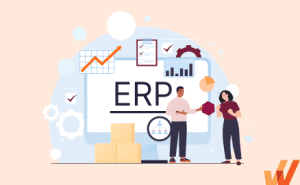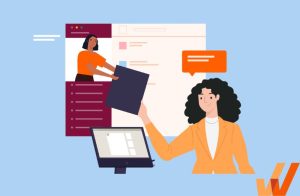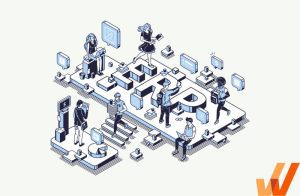How to Accelerate ERP Consolidation Projects (+Challenges)
- Published: May 3, 2024
- Updated: May 13, 2024

As enterprises grow, acquisitions and mergers are commonplace. Departments become siloed, regional offices open that fragment teams based on geographical areas, and subsidiary companies operate independently.
For CIOs and supply chain leaders, this often results in companies lacking ERP governance, with every subsidiary operating on its own ERP system. As companies look to push efficiency, CIOs of large enterprises are looking to consolidate their ERP systems into a single instance, combining legacy ERPs and single-module accounts payable, finance, billing, and procurement systems from across the organization into a single, powerful ERP system.
ERP transformation projects to consolidate multiple software systems and shadow IT into one centralized ERP system is a challenging migration project that presents many roadblocks but presents too many benefits to push off any longer.
For this article, we interviewed a CIO of a multinational food & beverage company with 80,000+ employees that was in the beginning stages of an ERP consolidation project. It currently uses 45 different ERP systems across its 72 subsidiary companies. It also had different ERP processes depending on the geographical region of each department (ie. the North American procurement division operated differently than the Middle East division.)
The company desired to consolidate all of these siloed teams and subsidiaries into one ERP system to streamline workflows, reduce IT costs, and centralize data to make better, smarter decisions.
In this article, we’ll discuss the benefits of merging and consolidating multiple ERP systems into one centralized application, and how enterprises can accelerate this process by communicating change, supporting employees in the flow of work with in-app ERP-guided experiences, and analyzing end-user behavior to analyze ERP user adoption and process governance with Whatfix for ERP systems.
What Is ERP Consolidation?
ERP consolidation is the process of merging multiple ERP systems into one single ERP system that is used across the organization, from accounts payable, procurement, customer relations, employee data, etc.
This may be caused by organizations acquiring small companies or merging with another enterprise, both of which use independent ERP systems and have their own processes. It can also happen when companies break out regional departments, with each geographical office and business division having various systems and ERP processes.
Another cause is enterprises using individually-packaged business module systems to handle unique business challenges, like procurement, billing, vendor management, etc. These two factors together can cause organizations to have dozens of ERP applications.
In any case, ERP consolidation enables CIOs and IT teams to identify all ERP systems used across the organization and begin to craft a migration plan to bring all systems and processes together under one umbrella, with one large ERP system becoming the defacto system that allows organizations to retire legacy systems and shadow IT.
Benefits of ERP Consolidation
With a single ERP system, all product, service, vendor, customer, and employee data, communication, and history are stored in one, centralized system – enabling enterprises to scale, optimize processes, and achieve new business objectives and outcomes.
Here are the main benefits of ERP consolidation:
- ERP process governance. Consolidation of ERPs allows for companies to focus on building the most efficient ERP processes that drive productivity, compliance, and revenue. With a single ERP system, teams can analyze process efficiency, map optimal processes, and create governance resources to ensure ERP processes are followed correctly.
- Better data integration and quality for smart decision-making. By centralizing ERP systems into one, it provides a single database that houses all your accounts payable, finance, customer, and employee data in one single platform – helping your various leaders and team members make better, data-driven decisions.
- Reduced IT cost. By consolidating ERP systems, companies can reduce the number of software subscriptions that cause SaaS waste and drag down technology budgets. It also allows companies to reduce maintenance costs by sunsetting legacy ERPs systems which eliminates upkeep, maintenance, and support costs for these outdated systems.
- Better user experience. With a single ERP, IT teams can focus on making a UX that works for their employees. This allows organizations to have a consistent ERP user experience no matter their subsidiary, business unit, or geographic region.
- Centralized ERP user support. With one ERP, IT can provide better ERP end-user support with more expert IT support, more comprehensive support resources and help content, and better ERP user onboarding and training, etc.
- Enables employees to move throughout the company. With a single ERP, employees are empowered to transfer throughout the organization’s divisions and regions, as all teams use the same ERP system, helping to ease the transition by providing a familiar system and user experience.
Challenges of ERP Consolidation Projects
While ERP consolidation projects can transform enterprise operations and processes, they’re major transformation projects that require tedious planning, communication, and IT support to facilitate a smooth transition and successful ERP consolidation.
Here are the main challenges enterprises must overcome when consolidating ERP systems:
1. ERP data migration
A main benefit of ERP consolidation is having all your data in one centralized application. However, this requires organizations to migrate all historical financial, customer, product, and employee data from legacy systems to the main ERP. This is critical to your ERP consolidation success, as importing dirty data can instantly negate the benefits of the entire consolidation project.
2. Resistance to change and employee buy-in
Employees who used the ERP systems you’re retiring will need to be shown the benefits of why they’re being asked to use a new system. In some cases, employees may have used the outdated ERP and its processes for years and may feel it is unwarranted and show resistance to change.
Change leaders will need to communicate the “why” behind the change, involve stakeholders from all levels and departments, and work with all employees impacted by the change to ensure a smooth, effective transition that works for all employees.
3. Downtime and work disruptions
When you first migrate to a single ERP, there will be work disruptions as employees use new systems with unfamiliar processes. Plan for this downtime with additional IT support, self-help resources, and potentially even communicating with your customers to let them know of the large-scale transformation project happening behind the scenes.
4. ERP user training and support
To mitigate downtime and work disruptions, you’ll need to provide contextual ERP user onboarding and training to all employees before the system goes live. You can do this with sandbox ERP training environments, SOPs, ERP in-app guidance once the system goes live, and by bringing in temporary in-house ERP-certified trainers.
5. IT costs
There will be upfront and temporary costs associated with ERP consolidation projects. You will need to account for:
- Increased cost of your main ERP system to account for new features, modules, and user licenses.
- ERP implementation partners and consultation services.
- New ERP end-user onboarding, training, and support materials and resources.
- Creating sandbox ERP environments for testing and user training.
- Added IT support for overcoming end-user issues post-deployment.
- Overall time and resource commitment from various leaders across the organization, including finance, customer-facing teams, sales, product, operations, HR, IT, and more.
How to Accelerate ERP Consolidation With Whatfix
ERP consolidation projects are high-risk, high-reward projects that organizations will eventually need to confront head-on to build a sustainable, scalable ERP technology infrastructure. For many organizations, ERP systems are mission critical, with their core operations not being able to function without it.
Whatfix empowers organizations to realize the value of their ERP investments, accelerate transformation projects, maximize ERP ROI, and achieve business outcomes.
Whatfix offers three no-code products that drive ERP adoption, accelerate ERP implementations, and enable enterprises to successfully consolidate ERP systems with minimal user downtime and fast time-to-proficiency.
- Whatfix DAP to enable ERP end-users with contextual in-app guidance and on-demand help that supports employees in the flow of work.
- Whatfix Mirror to quickly create ERP sandbox environments for hands-on simulated training and user testing.
- Whatfix Product Analytics to empower ERP application owners and department leaders to capture ERP end-user behavior, product usage, and process completion rates to capture specific user events, identify areas of friction, map optimal journeys, and take a data-driven approach to ERP governance, process mapping, and user adoption.
With Whatfix, organizations can overcome the challenges of ERP consolidation and transformation projects by focusing on the end-user experience, including:
1. Easily create ERP sandbox environments for hands-on user training
With Whatfix Mirror, IT teams can quickly create ERP sandbox environments. This enables organizations to conduct user testing before launch to identify friction areas and ensure processes work smoothly.
More importantly, it provides a simulated ERP user onboarding experience during migration and for newly onboarded employees who provide hands-on training without impacting real ERP data or processes. Employees can interact with ERP processes, navigate through the modules and tasks they’re responsible for, and run through guided experiences and scenarios – all without the fear of impacting actual operations or impacting your ERP’s data quality.
2. Create role-based ERP end-user guidance
ERPs are used by countless teams and departments, with use cases ranging from accounts payable, procurement, audits, billing, vendor management, customer relations – the list goes on. ERPs are also highly customized to meet the specific needs of organizations and departments.
With Whatfix, create role-based ERP in-app guidance that provides contextual information and support to your various end-users in the flow of work.
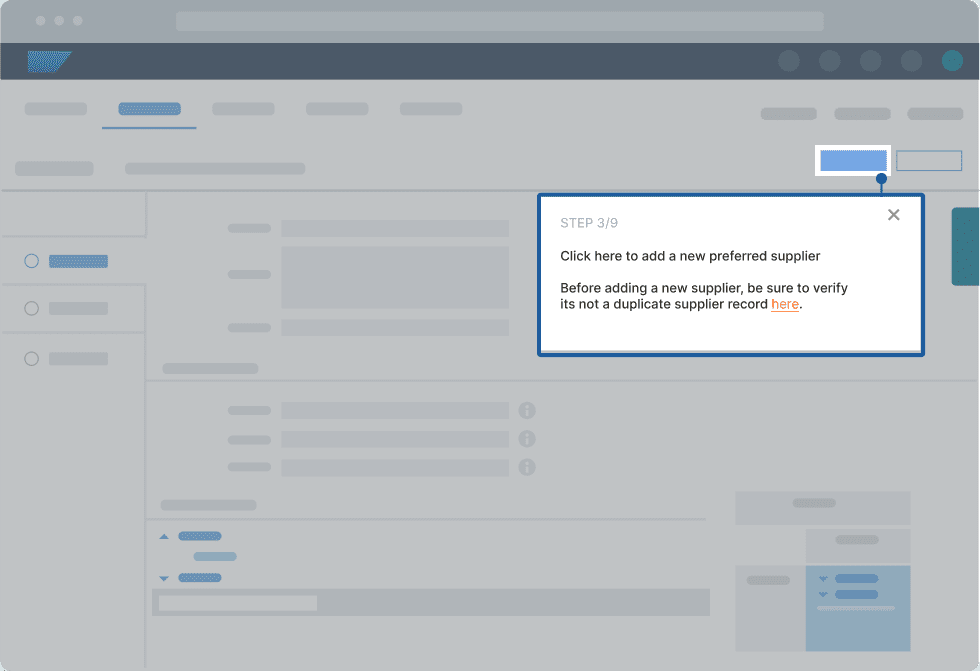
With Whatfix, create role-specific in-app experiences contextual to where users are in an ERP, like:
- In-app Flows to walk end-users step-by-step through complex ERP tasks.
- Task Lists to onboard new ERP end-users and guide them through their first steps and core workflows.
- Pop-Ups to drive awareness of ERP process changes, make team announcements, alert users to upcoming deadlines or new compliance laws, announce new training resources, and more.
- Smart Tips to provide additional context or nudge different users to take specific actions.
- Field Validation to ensure that your ERP end-users enter data in the correct format.
3. Provide real-time user support in the flow of work
With Whatfix, go beyond ERP user onboarding and one-time training with Self Help. Self Help provides an on-demand, in-app help center that overlays your ERP UI. ERP users can use its search function to find any help or support resource they need, at the moment of need, without leaving the application. Self Help also presents contextual support and information depending on where a user is at in your ERP.
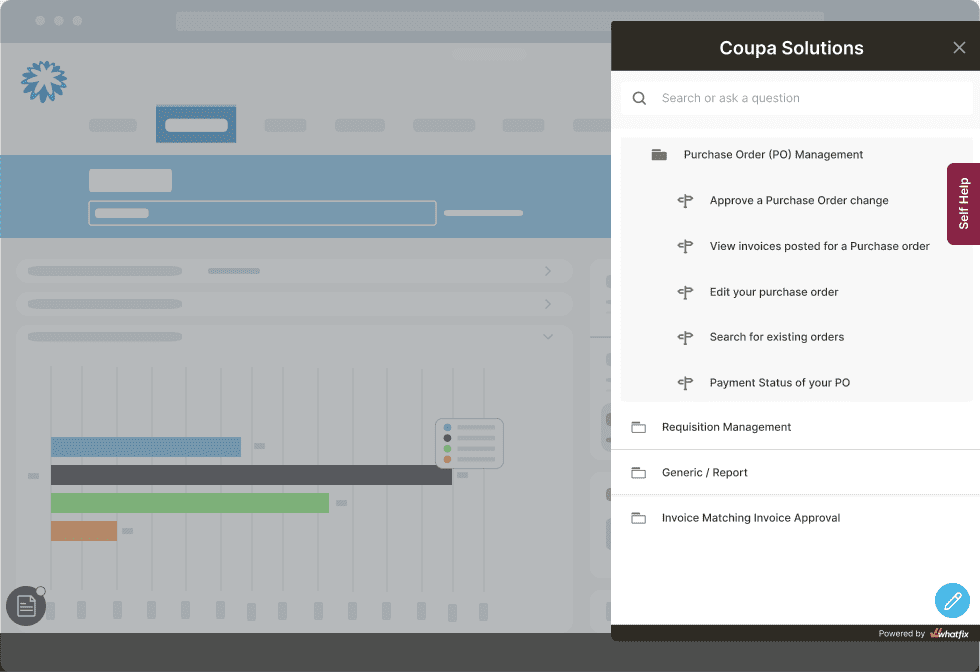
Self Help integrates with your ERP training resources, IT Help Desk, SOPs, LMS, vendor support content, third-party links, and more – aggregating it into a searchable self-help wiki. Attach Self Help entries to in-app guided Flows that are prompted when an end-user interacts with the widget. Analyze what your end-users are searching for and are experiencing friction with to identify areas of ERP improvement and new support resources to create.
Renewables energy enterprise REG partnered with Whatfix to support its JD Edwards ERP transformation project. With Whatfix’s in-app guidance, user support, and process analytics, REG reduced its ERP time-to-proficiency for new users by 50%, equal to a 3-month reduction in getting new employees up to speed with its highly customized JD Edwards ERP instance. Self Help enabled its ERP users with on-demand support, deflecting ERP-related support tickets which resulted in a 600% reduction in application-related support cases and tickets.
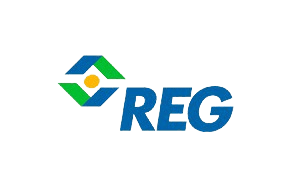
Abby Essing, Sr. Manager, Operations Services at Renewable Energy Group, Inc.
4. Localize ERP in-app guidance and support
Many ERP consolidation projects will need to provide support for their ERP users who are distributed across the global. This presents challenges such as language localization, compliance and regulation requirements, and other regional issues.
With Whatfix, automatically localize your ERP in-app guidance and support content to your end-users, providing personalized support to each end-user. Whatfix supports over 80 languages, providing global content localization and auto-translation features that enable your global ERP end-users, no matter their native or preferred language.
5. Take a data-driven approach to ERP process optimization and UX improvements
Post-ERP implementation, IT teams are faced with challenges of tracking workflow efficiency, testing ERP improvements, optimizing ERP processes, governing ERP processes, and improving user adoption.
Whatfix provides two solutions to enable IT teams with the data and insights they need to make ERP improvements and drive ROI.
Guidance Analytics provides insights into how your ERP users consume and engage with you in-app Whatfix content. Track how many users completed their new user Task List, how many user engaged with a Smart Tip, how many users clicked on the CTA in an announcement Pop-Up, or what are the most searched queries in Self Help.
Whatfix Product Analytics provides ERP application owners with a full no-code event tracking solution to track any custom user action or event. User Funnels and Journeys allow application leaders to identify areas of friction, processes with low completion rates, and where dropoffs occur. Compare segments of users (like departments or regional offices) against one another with Cohorts to identify if adoption or governance issues stem from specific locations or groups of users.
With Whatfix Product Analytics, take a continuous, data-driven approach to your ERP UX to create optimal workflows that enable users with frictionless processes and unlock the true potential of your ERP system.
Ready to accelerate your ERP consolidation initiative and maximize your ERP transformation investment? Request a Whatfix demo!

Thank you for subscribing!

